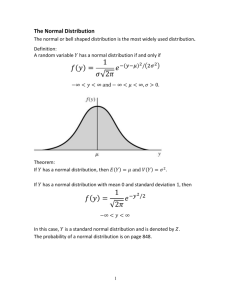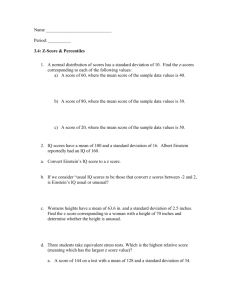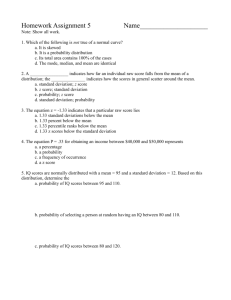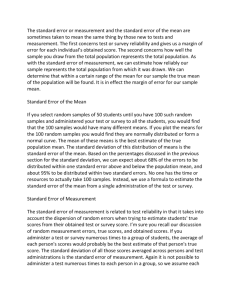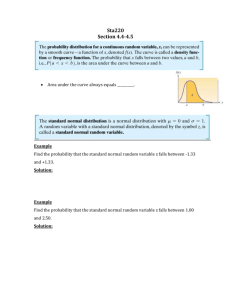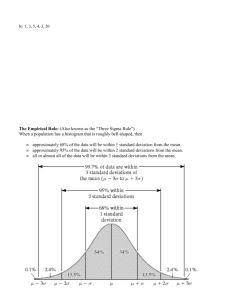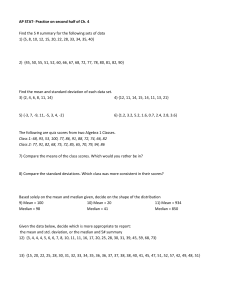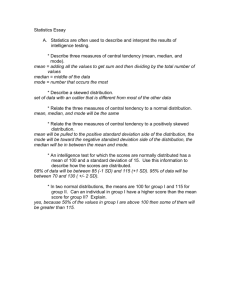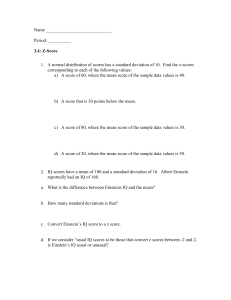ou-lesson 10 - CLSU Open University
advertisement
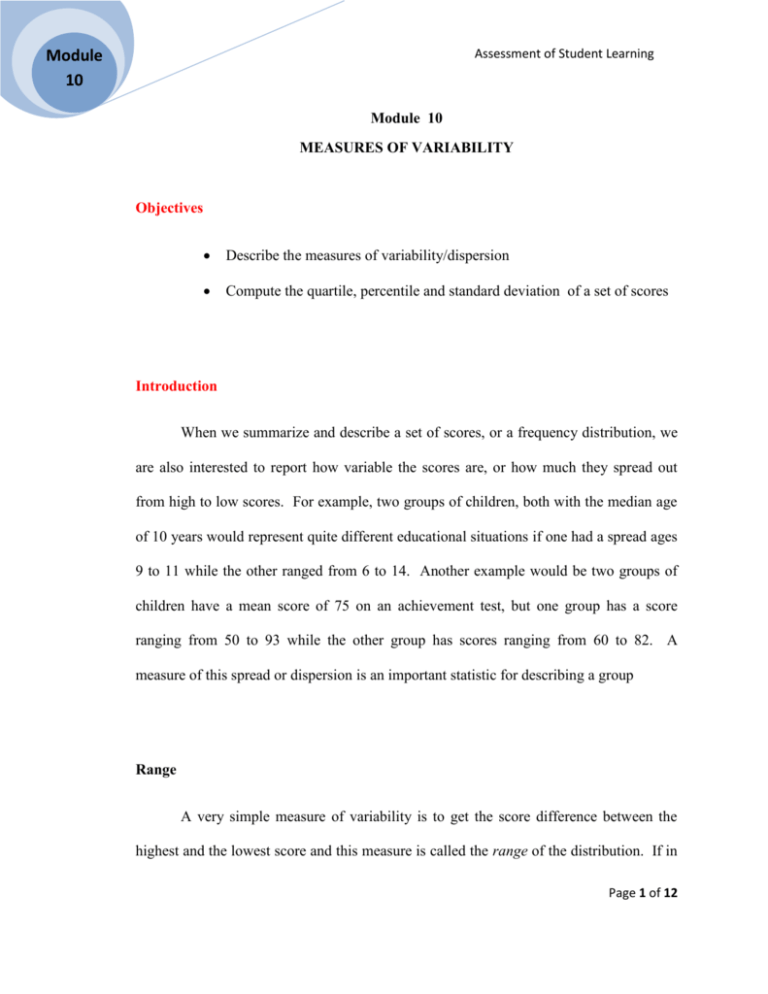
Assessment of Student Learning Module 10 Module 10 MEASURES OF VARIABILITY Objectives Describe the measures of variability/dispersion Compute the quartile, percentile and standard deviation of a set of scores Introduction When we summarize and describe a set of scores, or a frequency distribution, we are also interested to report how variable the scores are, or how much they spread out from high to low scores. For example, two groups of children, both with the median age of 10 years would represent quite different educational situations if one had a spread ages 9 to 11 while the other ranged from 6 to 14. Another example would be two groups of children have a mean score of 75 on an achievement test, but one group has a score ranging from 50 to 93 while the other group has scores ranging from 60 to 82. A measure of this spread or dispersion is an important statistic for describing a group Range A very simple measure of variability is to get the score difference between the highest and the lowest score and this measure is called the range of the distribution. If in Page 1 of 12 Assessment of Student Learning Module 10 a reading test for example, the highest score is 90 and the lowest is 41, the range is 49. However, the range depends only upon the 2 extreme scores in the total group. This makes this measure a very unreliable because it can be changed a good bit by the inclusion or omission of a single extreme case. The example below illustrates that the range of a set of scores is affected by a single extreme score Group 1 45 50 76 77 80 81 90 95 Group 2 25 50 76 77 80 81 90 95 Semi-Interquartile Range or Quartile Another measure of variability is the range of scores that includes a specified part of the total group – usually the middle fifty percent. The middle fifty percent of the group are scores lying between the 25th and 75th percentiles. The 25th(Q1)and 75th (Q3) percentiles are called quartiles since they cut off the bottom quarter and the top quarter of the group respectively. The score distance between them is called the interquartile range .The statistic that is often reported as a measure of variability is the semi-quartile range (Q), which is half of the interquartile range. So, Q = Q3-Q1 2 Page 2 of 12 Assessment of Student Learning Module 10 How to compute for Q 1and Q3 X 95-99 90-94 85-89 80-84 75-79 70-74 65-69 60-64 55-59 50-54 45-49 40-44 f 3 4 5 8 6 10 4 4 2 0 1 3 cf 50 47 43 38 30 24 14 10 6 4 4 3 Q3 Q1 Q1 = LQ1+ i [(N/4 – cf)/ f Q1 ] Where : Q1 = the 25th percentile LQ1 = lower limit of the median class N = total number of frequencies in the distribution cf = cumulative frequency of the median class f Q1 = frequency of the median i = size of the interval of the median class So, Q1 = LQ1+ i (N/4 – cf )/ f Q1 = 64.5 + 5 (50/4 - 10)/4 = 64.5 + 5 (12.5-10)/4 = 64.5 + 5 (2.5/4) = 64.5 + 5(.63) = 64.5 + 3.15 = 67.65 Page 3 of 12 Assessment of Student Learning Module 10 Q3 = LQ3+ i (3N/4 – cf)/ f Q3 Where : Q3 = the 75th percentile LQ3 = lower limit of the median class N = total number of frequencies in the distribution cf = cumulative frequency of the median class fQ3 = frequency of the median i = size of the interval of the median class So, Q3 = LQ3+ i (3N/4 – cf)/ f Q3 = 79.5 + 5 (37.5- 30)/8 = 79.5 + 5 (7.5/8) = 79.5 + 5 (.94) = 79.5 + 4.7 = 84.2 Therefore: Semi-quartile range (Q) = 84.2 – 67.65 = 8.275 2 Percentiles The same procedure may be used when we find the score below which any percentage of the group falls. These values are called percentiles. The median is the 50th percentile, i.e., the score below which 50 percent of individuals fall. If we want to find Page 4 of 12 Assessment of Student Learning Module 10 the 40th percentile, we must find the score below which 40 percent of the cases fall. Any other percentiles can be found in the same way. Percentiles have many uses, especially in connection with test norms and interpretation of scores Below is an illustration how a particular percentile is computed. X 75-77 72-74 69-71 66-68 63-65 60-62 57-59 54-56 51-53 48-50 45-47 42-44 39-41 36-38 33-35 f 3 5 2 4 3 0 2 4 6 3 4 6 5 1 2 cf 50 47 42 40 36 33 33 31 27 21 18 14 8 3 2 N=50 For example, we are looking for the 20th percentile or the score in which 20 percent of the cases falls below it, then 20th percentile or P20 = LP20+ i (20%N – cf)/ f P20 = 41.5 + 3 [(.20x50)-8]/6 = 41.5 + 3 (10-8)/6 = 41.5 + 1.00 = 42.50 Page 5 of 12 Assessment of Student Learning Module 10 Standard Deviation or SD Standard Deviation or SD is a measure of dispersion among all scores in the distribution rather than through extreme scores of or only a proportion of the scores. It is the square root of the average of the squared deviation from the Mean. Finding the Standard Deviation of Ungrouped Scores Steps: 1. Find the Mean 2. Subtract the Mean from the scores 3. Square the deviation 4. Find the sum of the squared deviation (∑d2) 5. Divide the sum of the squared deviation by the number of cases 6. Find the square root of the answer in step 5 In symbol, SD = Where: d = deviation from the mean d2 = squared deviation ∑d2 = sum of the squared deviation Page 6 of 12 Assessment of Student Learning Module 10 Given these scores, let us find the S.D. Score 92 75 85 83 90 73 79 80 88 83 d +9 -8 +2 0 +7 -10 -4 -3 +5 0 d2 81 64 4 0 49 100 16 9 25 0 ∑d2= 348 N = 10 Mean = 83 SD = SD = SD = SD = 5.59 Finding the Standard Deviation of Grouped Scores For ungrouped data, we compute for the standard deviation by computing first for the actual Mean of the set of scores. For grouped data, standard deviation in computed from an “assumed mean”. To illustrate, study the example given. Page 7 of 12 Assessment of Student Learning Module 10 X 75-77 72-74 69-71 66-68 63-65 60-62 57-59 54-56 51-53 48-50 45-47 f 3 4 6 5 8 9 5 8 3 2 2 N=55 d 5 4 3 2 1 0 -1 -2 -3 -4 -5 fd 15 16 18 10 8 0 -5 -16 -9 -8 -10 +67 - 48 ∑fd = +19 fd2 75 64 54 20 8 0 5 32 27 32 50 ∑fd2 = 367 Steps: 1. Choose any step interval for the assumed mean as the arbitrary starting point or “origin”. In the example given, the interval 60-62 has been chosen. Call this interval zero, and the next higher interval +1, the lower interval -1, etc. These are shown in the column labeled d. (Note: Any interval can be chosen, and the final result will be the same) 2. Multiply frequency (f) by the number of deviations (d) and the resulting product is shown in column labeled fd. Get the sum of fd by taking into account the plus and minus signs. 3. To get fd2, multiply d by the fd. Then get the sum of fd2 Page 8 of 12 Assessment of Student Learning Module 10 Substitute the corresponding values to the formula: 2 S.D. = i Where, i= interval N = number of cases ∑fd = summation of frequency deviation ∑fd2= summation of frequency x squared deviation S.D. = 3 =3 2 2 =3 =3 = 3 x 2.56 = 7.68 Page 9 of 12 Assessment of Student Learning Module 10 Summary To represent the spread of scores, the range is the quickest measure. However, the range is an unreliable measure because it greatly depends on extreme scores. Statisticians have developed the semi-interquartile range, half the distance between the 25th and 75th percentile as a more reliable measure of dispersion. We can also use percentiles to determine the score by which certain percent of the cases fall below it. Finally, a measure of variability/dispersion that involves all scores in the distribution is the standard deviation, a type of average of the deviations of the scores away from the average (Mean). For ungrouped data, standard deviation is computed from the actual mean while for the grouped data, it is computed from an assumed mean of the distribution. Page 10 of 12 Assessment of Student Learning Module 10 Activity 1 1. Compute for the Semi-quartile range (Q) and the 60th percentile of the frequency distribution X 90-94 85-89 80-84 75-79 70-74 65-69 60-64 55-59 50-54 45-49 f 2 2 5 7 10 11 8 3 0 2 2. Using the set of scores to illustrate finding the standard deviation of grouped scores, choose another step interval for the assumed mean and show that the standard deviation of the distribution is also equal to 7.68. 3. Compute for the standard deviation of both Section A and Section B. Compare results, discuss differences if any. Page 11 of 12 Assessment of Student Learning Module 10 Section A X 90-94 85-89 80-84 75-79 70-74 65-69 60-64 55-59 50-54 45-49 Section B X 90-94 85-89 80-84 75-79 70-74 65-69 60-64 55-59 50-54 45-49 40-44 35-39 30-34 f 2 2 5 7 10 11 8 3 0 2 f 2 2 5 7 10 11 5 3 0 2 1 1 1 Activity 2. Share significant insights gained from the module. Page 12 of 12
